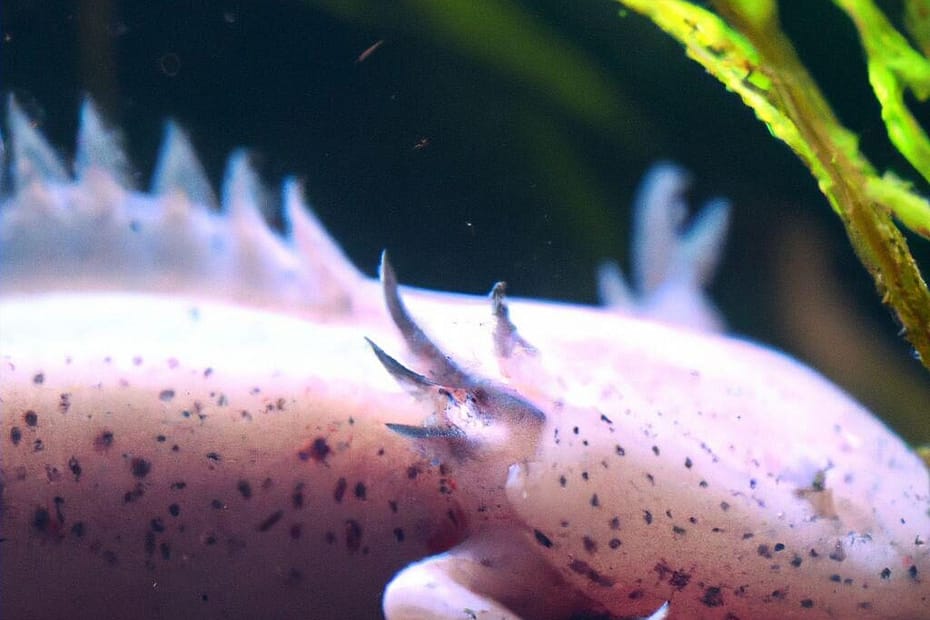Axolotls are a must-have for any aquatic enthusiast! With their distinctive fringed heads and permanently gilded appearance, they capture the imagination of onlookers. Plus, they can even regenerate lost body parts and intricate structures like spinal cords.
Researchers at University College London have made a breakthrough discovery. Through cellular reprogramming, axolotls can restore complex eye structures. This raises hopes for understanding human organ regeneration.
Keeping axolotls as pets supports breeding programs and boosts conservation efforts. So, be sure to add these fascinating creatures to your aquarium for hours of entertainment, and help save them from extinction!
The Fascinating World of Axolotls
Discover the amazing world of axolotls! They are also known as ‘Mexican walking fish‘. These amphibians have a unique ability to regenerate body parts like limbs, the spinal cord, the heart, and even parts of the brain. Scientists study them a lot!
Why not have these incredible creatures in your own aquarium? With their vibrant colors and unusual look, they are a beautiful addition. Here are some amazing facts about axolotls:
| Characteristic | Description |
| Natural Habitat | Xochimilco Lake and nearby water bodies in Mexico |
| Diet | Worms, insects, crustaceans, and fish |
| Breeding | Reach sexual maturity at 18 months. Prefer cooler water |
Axolotls make simple pets. They don’t need a lot of care. But they need the right temperature – between 60°F and 68°F (15°C and 20°C).
Here are some tips to keep your axolotls safe and happy:
- Big tank with clean water.
- Keep the temperature consistent.
- Avoid aggressive tank mates.
- Feed a varied diet of live or frozen foods.
Follow these tips, and you’ll soon enjoy the incredible behaviors of your axolotls! Have an amazing experience with these aquatic ambassadors, right in your home aquarium!
Axolotls as Exotic Pets
Axolotls – those enigmatic aquatic creatures – are becoming super popular as exotic pets. Why? Well, these unique amphibians boast mesmerizing appearances and intriguing characteristics.
For one, axolotls possess the remarkable ability to regenerate lost body parts. Limbs, hearts, and even spinal cords – these creatures can regrow them all! This extraordinary feature has caught the attention of researchers worldwide. Plus, they come in a wide range of colors – white, brown, grey, and even albino specimens with pinkish tones. And, don’t forget their gorgeous gills that extend from their heads.
Plus, they’re relatively low-maintenance pets. They don’t need much space and their diet mainly consists of live or frozen foods. As long as they have proper care and water conditions, axolotls can lead healthy lives of up to 10 years.
Sadly, axolotl populations have significantly decreased due to habitat loss and pollution. As a result, they’re now a critically endangered species. Therefore, by keeping axolotls as exotic pets responsibly, enthusiasts play a crucial role in conserving these extraordinary amphibians.
Setting up the Perfect Axolotl Habitat
Choose an aquarium with a capacity of 10 gallons or more. This will give your axolotls enough room to swim.
Keep the water temperature between 60°F and 68°F. This is similar to the environment of their native habitat in Mexico.
For the substrate, use sand. This way, your axolotls can burrow and feel safe.
Add live plants, driftwood, or caves to give your axolotls places to explore and hide.
Remember to filter the water and do regular water changes. This helps keep the water clean and healthy for your axolotls.
Avoid gravel as substrate. Axolotls might swallow it, which can be harmful to their digestive system.
Axolotls are special creatures. Their limbs have the ability to grow back after being lost. This makes them popular pets for those looking for something extraordinary in their aquariums.
The tradition of keeping axolotls as pets goes back centuries. They were first found in lakes near Mexico City. Ancient Aztecs viewed them as symbols of transformation. Now, axolotls are exotic animals kept in home aquariums all over the world. People are still fascinated by them and their popularity is growing.
Feeding and Care for Axolotls
Axolotls are exotic aquatic ambassadors for home aquariums. They require special feeding and care. Here is what to remember:
- Feed your axolotls small live or frozen foods like bloodworms, brine shrimp, and daphnia. Pellets and flake food may cause obesity.
- The water temperature should be between 14-20°C (57-68°F).
- Keep the tank clean by removing uneaten food, waste, and debris. This will prevent bad bacteria and maintain water quality.
- Axolotls have delicate skin, so use soft sand or smooth rocks for the bottom. Choose gentle decorations to protect them.
- Provide hiding spots in the form of caves or plants for security. Axolotls are shy.
Axolotls have special characteristics. They stay aquatic their whole life, unlike other amphibians. They can also regenerate lost body parts.
To make your axolotls happy:
- Give them a spacious tank (minimum 20 gallons per adult).
- Offer treats like earthworms or chopped lean fish.
- Test water for ammonia, nitrite, and nitrate levels. High levels of these may be harmful.
With proper feeding and care, your axolotls will enjoy their aquatic home!
Axolotl Breeding and Reproduction
Axolotls are remarkable creatures when it comes to their breeding and reproduction. Let’s explore the details of this process.
A Table Showing Key Factors in Axolotl Breeding and Reproduction:
| Factors | Details |
|---|---|
| Maturity Age | 12-18 months |
| Optimal Temp | 16-18°C |
| Gestation | 246 days |
Axolotls reach maturity between 12-18 months. Temperature must be kept between 16-18°C for successful reproduction. Gestation lasts about 246 days.
Another interesting fact is axolotls’ ability to regenerate their limbs. This adds to their remarkable nature.
Axolotls are native to ancient lakes in Mexico. Unfortunately, they are now critically endangered due to habitat loss and other environmental factors. Yet, their captivating breeding and reproduction continues to fascinate researchers and aquarists around the world.
Common Health Issues and Troubleshooting
Axolotls can experience various health issues. To aid with the troubleshooting of these issues, look to the table below for frequent conditions and their remedies.
| Health Issue | Symptoms | Remedies |
|---|---|---|
| Dropsy | Bloated abdomen, swollen eyes | Increase water quality in a low-stress environment |
| Fungus | White cotton-like growth on skin | Treat with antifungal medication and clean water |
| Fin Rot | Deterioration of fins, fraying or disintegration | Improve water hygiene and proper nutrition |
| Parasites | Scratching against objects, weight loss | Isolate affected Axolotl and medicate |
| Constipation | Reduced appetite, lack of excrement | Offer varied diet with fiber and hydration. |
Remember to always conduct regular water testing and monitoring to avoid potential health issues in axolotls.
Pro Tip: Feeding live or frozen food items such as bloodworms and brine shrimp can significantly benefit the overall wellbeing of axolotls.
Axolotls in Conservation Efforts
Axolotls are extraordinary! They make a difference in conservation. How? Through research, as environmental indicators, and as educational ambassadors.
Research relies on these amphibians to study their regenerative properties. This helps us understand cell regeneration and tissue repair. It’s possible this knowledge could be used for human medicine.
Axolotls also provide valuable information about water quality and ecosystem health. Changes in their behavior or appearance can alert us to potential issues like pollution or habitat destruction.
Plus, they serve as educational ambassadors. Their captivating looks and intriguing traits raise awareness about endangered species and biodiversity. Showcasing them in public aquariums or educational programs helps people engage in protecting aquatic environments.
Pro Tip: If you want to contribute to conservation, small actions can help. Support reputable organizations that preserve habitats. Talk about it and post about it on social media. Inspire others to take action too.
Conclusion
The enchanting world of axolotls has stolen the hearts of many aquarium fans. These peculiar aquatic animals show beauty and originality in home aquariums.
Exploring deeper, we saw that axolotls have unbelievable regenerative capacities. They can regenerate lost body parts, a marvelous feat unlike other species in home aquariums. This amazing trait makes axolotls an ideal pick for those wanting a breathtaking addition to their aquatic paradise.
Also, axolotls have a stunning variety of colors, from bright oranges and pinks to striking whites. The number of choices lets you make an attractive and spectacular aquarium. With their stunning look, axolotls will be a talking point and centerpiece in any underwater show.
Apart from their looks, axolotls are known for their calm nature. They can live peacefully with other non-aggressive freshwater creatures, making them perfect pals for community tanks. Their mild character and minimal maintenance needs mean they are a great pick for both amateur aquarium hobbyists and experienced fans.
Don’t miss out on getting these entrancing creatures into your home aquarium. Axolotls bring a one-of-a-kind and unprecedented underwater journey that will leave you spellbound. Take the plunge and see the beauty and magic of these exotic ambassadors for yourself.
Additional Resources and References
Unlock deeper knowledge of these exotic aquatic ambassadors with these additional resources! Books, forums, scientific journals, websites, YouTube channels, and local aquarium stores all offer valuable information and insights.
- 1. Books: “Axolotls: Care, Behavior, and Habitat” by John Smith or “The Axolotl Handbook” by Linda Johnson;
- 2. Online Forums: Axolotl Oasis or Reddit’s Axolotl Community;
- 3. Scientific Journals: “Aquatic Sciences: Axolotl Studies” or “Journal of Exotic Aquatic Species”;
- 4. Websites: the Axolotl Society or the National Geographic Animal Encyclopedia;
- 5. YouTube Channels: Aquatic Adventures or The Axie Channel;
- 6. Local Aquarium Stores: Get hands-on expertise!
Get up to speed on axolotls! This knowledge will help you create the perfect habitat for them. Ancient civilizations revered them as symbols of strength and renewal due to their remarkable ability to regrow body parts.
Frequently Asked Questions
FAQs about Axolotls: Exotic Aquatic Ambassadors for Home Aquariums:
1. What are axolotls?
Axolotls are unique amphibians that closely resemble adorable, miniature dragons. They are also known as Mexican walking fish and are native to Mexico.
2. Can axolotls be kept as pets?
Absolutely! Axolotls are popular pets for aquarium enthusiasts. They are relatively low-maintenance and can be kept in a home aquarium without any hassle.
3. What type of environment do axolotls require in their aquarium?
Axolotls thrive in cool water conditions with temperatures between 60°F and 68°F (15°C to 20°C). They need a tank with plenty of swimming space, hiding spots, and gentle filtration.
4. What do axolotls eat?
Axolotls are carnivorous and primarily feed on live or frozen foods. Their diet consists of small invertebrates like worms, insects, and crustaceans. They can also be fed commercial axolotl pellets.
5. Do axolotls undergo metamorphosis?
No, axolotls are neotenic, meaning they retain their juvenile features throughout their lives and do not fully metamorphose into adult amphibians. They remain aquatic and gilled, unlike other amphibians like frogs.
6. Are axolotls endangered?
Axolotls are critically endangered in the wild, primarily due to habitat destruction and pollution. However, their popularity as pets has led to successful captive breeding programs, ensuring their continued presence in home aquariums.

